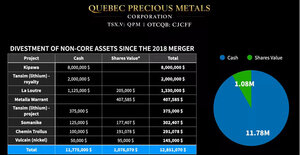The Gold Report: A report titled "M&A and Capital Raising in Mining and Metals, 1H 2014" from Ernest and Young (EY) says that mining and metals deal values in H1/2014 are "down 69% year-on-year, to $16.7 billion ($16.7B), from $53.8B, with deal volumes down 34% over the same period." Why aren't more mergers and acquisitions (M&A) happening in the precious metals space?
Michael Fowler: The first reason is that there are some big egos in the mining sector and some mining companies would prefer to go it alone or at least be in charge. But if both companies want to be in charge, someone is going to lose out. Ego is a big factor.
"Pretium Resources Inc. will be looked at strongly by some larger companies."
Job entrenchment is a second reason. CEOs, for example, want to keep their jobs versus being kicked to the curb.
Third is asset quality. Miners looking at other companies believe that their own assets are of superior quality and those of targeted companies are poor. Generally, asset quality is not high.
Number four is transaction costs. It costs a lot of money to make a transaction, especially for small companies with limited cash.
TGR: Obviously, there were more transactions last year and the quality of assets couldn't have changed a lot since. How do you define poor quality?
MF: We define that by the return to the prospective acquirer. As companies look at some of these assets, they see decreasing mining grade or reserve grade. That means cash margins will be less than what they would have been, say, 10 years ago. Grade plays a large role in determining the economics of putting a deposit into production and making a profit. I should note, too, that recently I have seen too many overly optimistic feasibility studies and scoping studies or what they now call preliminary economic assessments (PEA). Generally, asset quality isn't that high.
TGR: Overly optimistic feasibility studies and PEAs. Are you suggesting that recoveries won't be as high as expected? That capital numbers are generally too low? Mine life will be shorter? All of the above?
MF: All of the above and more, particularly in the case of PEAs. The stated returns in some of these reports are far too optimistic.
TGR: EY estimates that mining-focused private equity funds may have as much as $10B ready to deploy in the mining sector. What is private equity seeking?
MF: Most of the private equity firms want big assets. They are not interested in small exploration plays or tiny companies. They want assets that are in production or near production, perhaps offloaded by majors looking to trim debt; other targets could be companies with big development projects with juicy returns. Pretium Resources Inc. (PVG:TSX; PVG:NYSE) is one example. In April, Boston-based Liberty Metals & Mining Holdings bought roughly 5.78 million (5.78M) Pretium common shares at CA$6.92 apiece and received a seat on the board. Private equity wants to be involved in the decision-making.
TGR: Typically, how large are these private equity deals?
MF: Private equity generally wants to have a big chunk of a company, typically 10–20%, maybe more in some cases. It's about having a say in what these companies do.
TGR: Why not outright takeovers?
MF: A huge amount of private equity has not been deployed into the resource business. I don't think private equity is particularly comfortable with it. Most private equity managers don't have the expertise to actually run a mine. They generally prefer a big stake, but not actually run the company.
TGR: Are institutional bidders going to start bidding up these stocks or does the market rise owing to greater M&A speculation and activity? Which comes first?
MF: The institutions are going to be more actively involved in the space but they want to see more cost cutting, better earnings and cash flow, and generally good fundamentals in the gold sector. Institutions shunned the sector because there was tremendous cost inflation. Now it's going the other way. If the gold price goes up, M&A activity will gain steam.
TGR: If M&A gains steam, who would be the likely aggressors? Is it the large-cap producers? The midtiers? Small cash-flowing juniors?
MF: The majors are still in the game for good quality assets. We saw that with Yamana Gold Inc. (YRI:TSX; AUY:NYSE; YAU:LSE) and Agnico-Eagle Mines Ltd. (AEM:TSX; AEM:NYSE) taking over Osisko Mining. There are other assets out there with reasonable quality and some of the majors may well pick them up.
TGR: As you said, Osisko and Yamana just did a deal. Kinross Gold Corp. (K:TSX; KGC:NYSE) has taken some write-downs, as have Barrick and Newmont. With the exception of Goldcorp Inc. (G:TSX; GG:NYSE), the list of majors doesn't extend much beyond those names. It is generally understood that the major producers are focused on fixing internal problems, many of which were caused by aggressive M&A.
MF: It's a good point but at the end of the day these companies have to face the reality that their reserves are depleting because they have not invested a lot in exploration. When we're talking about a $10B company, companies trading for, say, $200–300M are still doable for a major. The activity level won't be nearly the same as what it was in the past, but I can foresee an increase in that kind of transaction.
TGR: What else do you foresee in M&A?
MF: I also see an increase in juniors merging, despite what I said about egos. At the moment small producers don't receive much interest in the stock market so they will probably be forced to merge to reach a bigger critical mass. An example of that would be Primero Mining Corp. (PPP:NYSE; P:TSX) merging with Brigus.
TGR: Is it more cost effective to buy gold production than build it?
MF: No. If you look at where the producers are trading, there's not much to gain by taking over a producer based on the cost versus the return.
It does make sense, though, for majors to take over companies with development projects. Those are trading at much lower multiples than producing companies. There's an accretion factor to the bigger company in those transactions. An example would be Torex Gold Resources Inc. (TXG:TSX). That company is not in production but it's fully financed and its El Limon-Guajes gold-silver project is high grade. Torex is in the sights of some majors.
TGR: Did Torex finance El Limon-Guajes on favorable terms?
MF: It's $400M; the actual terms were LIBOR plus 4% or 5%, which is not bad. Then there's some hedging that goes with it. Torex actually got the money, which is a good thing.
TGR: How does the grade compare to similarly sized projects in Mexico?
MF: It's one of the highest grades out there and it should actually make some good money. That's why majors will certainly take a look at it.
TGR: In addition to El Limon-Guajes, Torex also has the Media Luna deposit, which has a large Inferred resource. Is that being priced into the stock?
MF: Probably not. Media Luna is an added bonus.
TGR: You mentioned Pretium earlier. Industry experts speak glowingly about the grade at Pretium and Brucejack's potential. But it's a complex project that's going to need some well-tread miners to make it work. Does that make selling that asset more difficult?
MF: Pretium is not a straightforward asset. It's not easy to define a resource when you have such a high-grade deposit, but if a suitor is looking at Pretium, that company is going to decide how it would mine Brucejack. It may be that it's not 2,000 tons a day through a mill but rather 1,000 tons. It's a great deposit but nobody will know the actual grade of Brucejack until it's mined. I still think that Pretium will be looked at strongly by some larger companies.
TGR: Do you believe that Pretium has already signed confidentiality agreements with potential suitors?
MF: The tire kickers are out there and looking at Pretium. They're probably trying to understand exactly how big this resource is, its grade and how it can be mined for a profit.
TGR: Do you formally cover Torex and Pretium?
MF: No. Our business deals more with smaller companies. I talk about the larger companies because, quite frankly, there's not a lot of interest in the smaller companies. There are some good investment ideas among the larger developers.
TGR: Are there other development plays with near-term production?
MF: I like Guyana Goldfields Inc. (GUY:TSX). It has the Aurora gold project in Guyana. It just did a deal with the World Bank's International Finance Company and it's now fully financed. It's looking good.
TGR: Guyana is not a jurisdiction that most people are familiar with. Are other significant mines operating in Guyana?
MF: Guyana was put on the map by Cambior when it started mining the Omai gold mine in 1993. Next door, there's Gros Rosebel in Suriname, which is still being mined by IAMGOLD Corp. (IMG:TSX; IAG:NYSE). I say Suriname because it's still part of the Guiana Shield in South America. The government of Guyana is fairly mining-friendly and it generally follows British law. It's not a bad spot to be, although there is a net smelter royalty on production.
TGR: Is the royalty worse than what companies have to pay in Mexico?
MF: Guyana's tax regime is not too bad. The royalties and mining taxes are all in one package. Guyana Goldfields should make very good returns from its Aurora project, despite the royalty.
TGR: What are some smaller producers you're following?
MF: I like companies with nice growth potential. Many of the senior producers are offloading assets, lowering their costs and there's not much growth there.
I like midtier producers like Randgold Resources Ltd. (GOLD:NASDAQ; RRS:LSE), SEMAFO Inc. (SMF:TSX; SMF:OMX), Centamin Plc (CEE:TSX; CNT:ASX, CEY:LSE) and Alamos Gold Inc. (AGI:TSX). Those are good growth stories that are in good financial shape.
TGR: Randgold, Centamin and SEMAFO are all based primarily in different parts of Africa. Is it easier to grow a mining company in African countries?
MF: Companies like Randgold, SEMAFO and, to a certain extent, Centamin, have a fair amount of experience in Africa. Randgold is in Mali, Burkina Faso and the Democratic Republic of the Congo (DRC). It understands operating in these countries. SEMAFO has been in Burkina Faso for quite a few years. It's a similar story for Centamin in Egypt. It can be difficult to produce gold in Africa but if you have experienced people and good operators, it's doable.
Alamos is different. It's has been successful in Mexico but now it's making a foray into Turkey, which is causing some issues. But, generally, those are growth companies.
TGR: Randgold is having some teething issues at the Kibali operation in the DRC. Is that a concern?
MF: Randgold started well at Kibali then had a problem in the underground. Generally, the grade is good and the company should be able to expand production there. It also has AngloGold Ashanti Ltd. (AU:NYSE; ANG:JSE; AGG:ASX) as a joint operator. Overall, it has been a reasonable startup. There have been much worse startups in other countries, like Canada, for example.
TGR: SEMAFO has a development project in Burkina Faso. What do you know about that?
MF: That's very positive. There was always a feeling that the grade at Mana would go down and therefore production would, too. But SEMAFO found a satellite gold deposit not far from its Siou mill. It's high grade, the stripping ratio is favorable and is certainly accretive to production, cash flow and earnings. That's a big positive. I see SEMAFO growing in the future. The company also rid itself of some poorly performing assets, one in Guinea, the other in Niger. It's focused on Burkina Faso.
TGR: Do you see SEMAFO playing a role in the next round of M&A?
MF: I see it potentially getting involved in M&A, but it may not be by choice. Someone may come along and attack the company. When I last talked with management my understanding was that it wants to stick to its knitting in Burkina Faso. But it certainly could be a target for someone else.
TGR: Alamos Gold has the Kirazli and Aği Daği development-stage gold projects in Turkey, which have yet to receive the required environmental permits. Does the company have the right people to work out those issues in Turkey? Eldorado Gold Corp. (ELD:TSX; EGO:NYSE) has certainly had success there.
MF: Yes, Eldorado has done well. Alacer Gold Corp. (ASR:TSX: AQG:ASX) is in production at the Çöpler mine and is doing very well there. The basic mining environment in Turkey is not bad. Alamos has environmental issues to work through but it's only a matter of time before it is able to mine those projects. It took Eldorado time to get its environmental permits at some of its Turkish assets, too.
TGR: Let's talk about some companies you cover. One is Fortune Minerals Ltd. (FT:TSX). It recently received an extension to buy the 88% of the Revenue silver mine in Colorado that it doesn't already own. Does acquiring that asset finally get the market's attention?
MF: To be honest, I was a little surprised at what Fortune did. The market is a bit confused as well. Its former strategy was to finance or joint venture the NICO gold-cobalt-bismuth-copper project in the Northwest Territories, probably with help from an Asian company. Priority No. 2 was the Arctos coal deposit in British Columbia. The decision to buy the rest of the Revenue mine came out of the blue.
It was getting difficult to finance NICO and Fortune wanted to get some market attention in the short term by being opportunistic and buying a silver producer. I think the market is taking a wait and see attitude. After Fortune takes over this producer, it will get more market attention once it starts producing silver according to plan. There are a lot of risks associated with that plan but it could be a very good idea, should it work. Fortune has good, very chunky assets. Fortune could be a target for a private equity fund because it's got such big assets.
TGR: What other companies do you cover?
MF: One that I cover is St Andrew Goldfields Ltd. (SAS:TSX). Primero Mining bought Brigus Gold and its Grey Fox gold deposit, which is next to St Andrew's Hislop gold mine. The whole area is crying out for consolidation. I think that Primero bought the wrong company. Nonetheless, Primero started a process that is going to continue and St Andrew will be part of that consolidation at the end of the day.
St Andrew is a very inexpensive junior producer that produces about 85,000 ounces per year and that's not exciting the market. Some of these junior producers need to merge to reach a critical mass so that they can afford their fixed costs. There are potential synergies in the old Brigus and St Andrew because they're right next to each other.
TGR: What's St Andrew doing to lower its costs?
MF: It's efficiently mining. It is increasing the throughput at the Holt mill, which is an extremely good asset. Its main asset is the Holt mine. Next door to it is the Holloway mine and farther down the trend is Hislop. The Holt mine produces about 85% of its profits.
TGR: What are St Andrew's current all-in costs?
MF: About $1,050/ounce. The company published its earnings in mid-August, and those were nil versus nil so that's nothing to jump up and down about. I'm recommending it because it's very inexpensive and I see it as part of the M&A potential of that area.
TGR: You have been in this business for some time and you have seen market ups and downs. Please talk investors off the ledge.
MF: Keep the faith. There has been too much gloom and doom. It's a cyclical business and it will turn around. My favorite space at the moment is the junior to midtier producers. I see some of these stocks breaking out. The sentiment has definitely improved. As long as you're in good-quality stocks that are not a financial mess, you should see good returns.
TGR: Thank you for talking with us, Michael.
Michael Fowler, senior mining analyst with Loewen, Ondaatje, McCutcheon Ltd., has worked in the investment industry since 1987 as a base and precious metals mining analyst for numerous high-profile firms. His coverage list included the major North American gold mining companies, but is now focused on small- to mid-sized companies. Previously, Fowler worked as a geophysicist involved in mineral exploration for 10 years. He was involved in the discovery of the high-grade Cigar Lake uranium mine in Northern Saskatchewan in the early 1980s. Fowler holds a Master of Business Administration from Cranfield University, UK; a Master of Science in mineral exploration from Leicester University, UK; and a Bachelor of Science in geology with geophysics from Liverpool University, UK. He is a member of the Institution of Materials in the UK and a member of the Canadian Institute of Mining and Metallurgy.
Read what other experts are saying about:
Want to read more Gold Report interviews like this? Sign up for our free e-newsletter, and you'll learn when new articles have been published. To see recent interviews with industry analysts and commentators, visit our Streetwise Interviews page.
DISCLOSURE:
1) Brian Sylvester conducted this interview for Streetwise Reports LLC, publisher of The Gold Report, The Energy Report, The Life Sciences Report and The Mining Report, and provides services to Streetwise Reports as an independent contractor. He owns, or his family owns, shares of the following companies mentioned in this interview: None.
2) The following companies mentioned in the interview are sponsors of Streetwise Reports: Guyana Goldfields Inc., Pretium Resources Inc., Primero Mining Corp. and St Andrew Goldfields Ltd. Goldcorp Inc. is not affiliated with Streetwise Reports. Streetwise Reports does not accept stock in exchange for its services.
3) Michael Fowler: I own, or my family owns, shares of the following companies mentioned in this interview: None. I personally am, or my family is, paid by the following companies mentioned in this interview: None. My company has a financial relationship with the following companies mentioned in this interview: None. I was not paid by Streetwise Reports for participating in this interview. Comments and opinions expressed are my own comments and opinions. I had the opportunity to review the interview for accuracy as of the date of the interview and am responsible for the content of the interview.
4) Interviews are edited for clarity. Streetwise Reports does not make editorial comments or change experts' statements without their consent.
5) The interview does not constitute investment advice. Each reader is encouraged to consult with his or her individual financial professional and any action a reader takes as a result of information presented here is his or her own responsibility. By opening this page, each reader accepts and agrees to Streetwise Reports' terms of use and full legal disclaimer.
6) From time to time, Streetwise Reports LLC and its directors, officers, employees or members of their families, as well as persons interviewed for articles and interviews on the site, may have a long or short position in securities mentioned. Directors, officers, employees or members of their families are prohibited from making purchases and/or sales of those securities in the open market or otherwise during the up-to-four-week interval from the time of the interview until after it publishes.

 Michael Fowler, senior mining analyst with Toronto-based Loewen, Ondaatje & McCutcheon, predicts when gold breaks out, mining M&A will take off. He expects the major producers to lead the next rush of M&A. The majors want development-stage companies with high-grade, near-term production assets, and Fowler suggests some targets in this interview with
Michael Fowler, senior mining analyst with Toronto-based Loewen, Ondaatje & McCutcheon, predicts when gold breaks out, mining M&A will take off. He expects the major producers to lead the next rush of M&A. The majors want development-stage companies with high-grade, near-term production assets, and Fowler suggests some targets in this interview with 








































